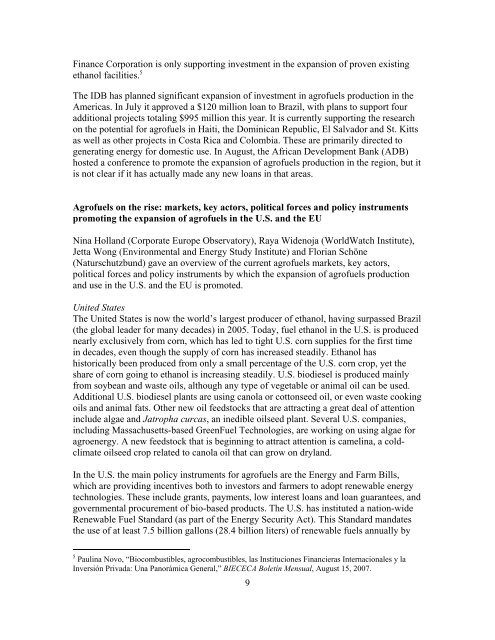Agrofuels: Opportunity or Danger? - Institute for Agriculture and ...
Agrofuels: Opportunity or Danger? - Institute for Agriculture and ...
Agrofuels: Opportunity or Danger? - Institute for Agriculture and ...
You also want an ePaper? Increase the reach of your titles
YUMPU automatically turns print PDFs into web optimized ePapers that Google loves.
Finance C<strong>or</strong>p<strong>or</strong>ation is only supp<strong>or</strong>ting investment in the expansion of proven existing<br />
ethanol facilities. 5<br />
The IDB has planned significant expansion of investment in agrofuels production in the<br />
Americas. In July it approved a $120 million loan to Brazil, with plans to supp<strong>or</strong>t four<br />
additional projects totaling $995 million this year. It is currently supp<strong>or</strong>ting the research<br />
on the potential f<strong>or</strong> agrofuels in Haiti, the Dominican Republic, El Salvad<strong>or</strong> <strong>and</strong> St. Kitts<br />
as well as other projects in Costa Rica <strong>and</strong> Colombia. These are primarily directed to<br />
generating energy f<strong>or</strong> domestic use. In August, the African Development Bank (ADB)<br />
hosted a conference to promote the expansion of agrofuels production in the region, but it<br />
is not clear if it has actually made any new loans in that areas.<br />
<strong>Agrofuels</strong> on the rise: markets, key act<strong>or</strong>s, political f<strong>or</strong>ces <strong>and</strong> policy instruments<br />
promoting the expansion of agrofuels in the U.S. <strong>and</strong> the EU<br />
Nina Holl<strong>and</strong> (C<strong>or</strong>p<strong>or</strong>ate Europe Observat<strong>or</strong>y), Raya Widenoja (W<strong>or</strong>ldWatch <strong>Institute</strong>),<br />
Jetta Wong (Environmental <strong>and</strong> Energy Study <strong>Institute</strong>) <strong>and</strong> Fl<strong>or</strong>ian Schöne<br />
(Naturschutzbund) gave an overview of the current agrofuels markets, key act<strong>or</strong>s,<br />
political f<strong>or</strong>ces <strong>and</strong> policy instruments by which the expansion of agrofuels production<br />
<strong>and</strong> use in the U.S. <strong>and</strong> the EU is promoted.<br />
United States<br />
The United States is now the w<strong>or</strong>ld’s largest producer of ethanol, having surpassed Brazil<br />
(the global leader f<strong>or</strong> many decades) in 2005. Today, fuel ethanol in the U.S. is produced<br />
nearly exclusively from c<strong>or</strong>n, which has led to tight U.S. c<strong>or</strong>n supplies f<strong>or</strong> the first time<br />
in decades, even though the supply of c<strong>or</strong>n has increased steadily. Ethanol has<br />
hist<strong>or</strong>ically been produced from only a small percentage of the U.S. c<strong>or</strong>n crop, yet the<br />
share of c<strong>or</strong>n going to ethanol is increasing steadily. U.S. biodiesel is produced mainly<br />
from soybean <strong>and</strong> waste oils, although any type of vegetable <strong>or</strong> animal oil can be used.<br />
Additional U.S. biodiesel plants are using canola <strong>or</strong> cottonseed oil, <strong>or</strong> even waste cooking<br />
oils <strong>and</strong> animal fats. Other new oil feedstocks that are attracting a great deal of attention<br />
include algae <strong>and</strong> Jatropha curcas, an inedible oilseed plant. Several U.S. companies,<br />
including Massachusetts-based GreenFuel Technologies, are w<strong>or</strong>king on using algae f<strong>or</strong><br />
agroenergy. A new feedstock that is beginning to attract attention is camelina, a coldclimate<br />
oilseed crop related to canola oil that can grow on dryl<strong>and</strong>.<br />
In the U.S. the main policy instruments f<strong>or</strong> agrofuels are the Energy <strong>and</strong> Farm Bills,<br />
which are providing incentives both to invest<strong>or</strong>s <strong>and</strong> farmers to adopt renewable energy<br />
technologies. These include grants, payments, low interest loans <strong>and</strong> loan guarantees, <strong>and</strong><br />
governmental procurement of bio-based products. The U.S. has instituted a nation-wide<br />
Renewable Fuel St<strong>and</strong>ard (as part of the Energy Security Act). This St<strong>and</strong>ard m<strong>and</strong>ates<br />
the use of at least 7.5 billion gallons (28.4 billion liters) of renewable fuels annually by<br />
5 Paulina Novo, “Biocombustibles, agrocombustibles, las Instituciones Financieras Internacionales y la<br />
Inversión Privada: Una Pan<strong>or</strong>ámica General,” BIECECA Boletín Mensual, August 15, 2007.<br />
9
















